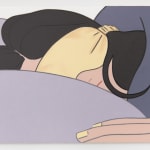Li Xia (绿李 Lilou Oh Yeah)
zZ, 2022
Oil on linen
51 x 35 1/2 in
130 x 90 cm
130 x 90 cm
LX0009
Copyright The Artist
$ 5,000.00
Further images
Lilou’s images, while clearly figurative, are not descriptive in any overt manner. She frames and blows up quotidian details in daily life. In her images, quiet moments of human interactions...
Lilou’s images, while clearly figurative, are not descriptive in any overt manner. She frames and blows up quotidian details in daily life. In her images, quiet moments of human interactions and scenes of domesticity, both realistic and imaginary, come alive: a mundane lamp, a grocery list, kissing lovers, a bite into a fresh strawberry, people sharing fruits, a tiny piece of tacky scotch tape… All seemingly insignificant details are magnified and explored with a warm touch of humor. Lilou’s tableaux emanate from real life. Cinematically framing banal details, her work invites the viewer into vignettes that capture the tension of familiar and overlooked moments. “I think in images,” according to the artist, “I like painting moments that do not show cause and effect, before and after. They are in a state of flux.”
We may find ourselves already familiar with Lilou’s fictional subjects. To the artist, a character is only a signifier, and she intentionally leaves out representational details that may give away the gender, racial or social identity of her protagonists. The figures in her work do not look directly at the viewer. They look away. They are detached. It is very important for the artist that the objects and figures in her work remain in their most natural state. They don’t pose for anyone. They are not being watched. This world is an open space that anyone can enter freely. In this world, bread dances, condensed milk speaks lover’s discourse and objects shift through stages of personification.
Precise and sensual, these meticulously constructed scenes are imbued with a sense of tranquility and surreal humor. Though decidedly lacking a distinct plot in her narrative, Lilou leaves traces that suggest something has just happened. Lilou’s pictures not only record events, they capture feelings – emotions buried deep in our consciousness. These neatly cropped-up scenes celebrate analog, delicious and, sometimes, forgotten moments in life. They act as a sort of visual fossil – evidence of our human existence – how we live, work and love.
Li Xia, also known as 绿李 Lilou Oh Yeah (b. 1991, Chongqing, China), lives and works in Rouen, France. Lilou attended the Université de Paris 1 Panthéon - Sorbonne (MFA, 2021), l'École Supérieure d’Art et Design Le Havre-Rouen (ESADHaR) (MFA, 2020) and Sichuan Fine Arts Institute (BFA, 2014). She has exhibited internationally at venues such as the LONG Museum, Minsheng Art Museum, Bananafish Gallery in Shanghai, China, Villa des Arts in Paris, France and Rola Bola in Rouen, France.
We may find ourselves already familiar with Lilou’s fictional subjects. To the artist, a character is only a signifier, and she intentionally leaves out representational details that may give away the gender, racial or social identity of her protagonists. The figures in her work do not look directly at the viewer. They look away. They are detached. It is very important for the artist that the objects and figures in her work remain in their most natural state. They don’t pose for anyone. They are not being watched. This world is an open space that anyone can enter freely. In this world, bread dances, condensed milk speaks lover’s discourse and objects shift through stages of personification.
Precise and sensual, these meticulously constructed scenes are imbued with a sense of tranquility and surreal humor. Though decidedly lacking a distinct plot in her narrative, Lilou leaves traces that suggest something has just happened. Lilou’s pictures not only record events, they capture feelings – emotions buried deep in our consciousness. These neatly cropped-up scenes celebrate analog, delicious and, sometimes, forgotten moments in life. They act as a sort of visual fossil – evidence of our human existence – how we live, work and love.
Li Xia, also known as 绿李 Lilou Oh Yeah (b. 1991, Chongqing, China), lives and works in Rouen, France. Lilou attended the Université de Paris 1 Panthéon - Sorbonne (MFA, 2021), l'École Supérieure d’Art et Design Le Havre-Rouen (ESADHaR) (MFA, 2020) and Sichuan Fine Arts Institute (BFA, 2014). She has exhibited internationally at venues such as the LONG Museum, Minsheng Art Museum, Bananafish Gallery in Shanghai, China, Villa des Arts in Paris, France and Rola Bola in Rouen, France.









